
|
|
|
|
BY: SUN STAFF
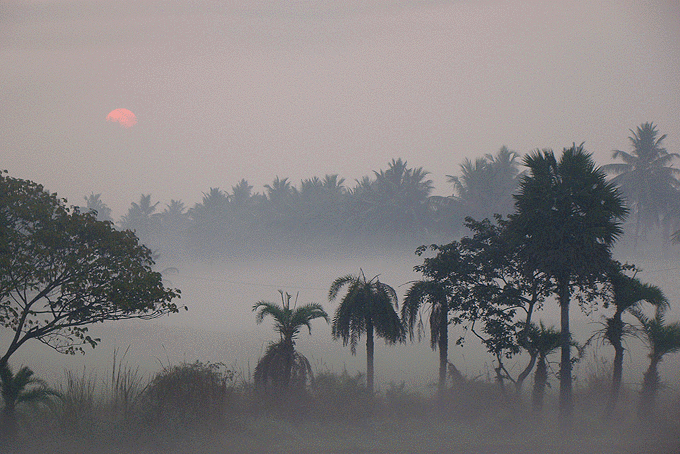
Sunrise on the Godavari at Gautami-ganga Mar 08, CANADA (SUN) — A serial exploration of the holy sites visited by Lord Caitanya. Gautami-ganga
Today we go back to Andhra Pradesh, where Lord Caitanya Mahaprabhu visited many sacred sites. As we see in the Summary of Sri Caitanya-caritamrta Madhya Lila 9, although yesterday's tirtha, Vrddhakasi is mentioned in the same paragraph as Gautami-ganga, the former is in Tamil Nadu, a long distance south from the latter.
Madhya lila 9 "A summary of the Ninth Chapter is given by Srila Bhaktivinoda Thakura. After leaving Vidyanagara, Sri Caitanya Mahaprabhu visited such places of pilgrimage as Gautami-ganga, Mallikarjuna, Ahovala-nrsimha, Siddhavata, Skanda-ksetra, Trimatha, Vrddhakasi, Bauddha-sthana, Tirupati, Tirumala, Pana-nrsimha, Siva-kanci, Visnu-kanci, Trikala-hasti, Vrddhakola, Siyali-bhairavi, Kaveri-tira and Kumbhakarna-kapala." Later in Madhya Lila 9.14, we find some very interesting details on Gautami-ganga: Madhya 9.14
"While walking on the road, Sri Caitanya Mahaprabhu used to chant this Rama Raghava mantra. Chanting in this way, He arrived at the banks of the Gautami-ganga and took His bath there. PURPORT Srila Bhaktivinoda Thakura says that Srila Kaviraja Gosvami has recorded the names of the holy places visited by Sri Caitanya Mahaprabhu but that there is no chronological order of the places visited. However, there is a notebook of Govinda dasa's containing a chronological order and references to geographical positions. Srila Bhaktivinoda Thakura requests the readers to refer to that book. According to Govinda dasa, Sri Caitanya Mahaprabhu went to Trimanda from the Gautami-ganga. From there He went to Dhundirama-tirtha, another place of pilgrimage. According to Sri Caitanya-caritamrta, after visiting the Gautami-ganga, Sri Caitanya Mahaprabhu went to Mallikarjuna-tirtha." The Rama Raghava mantra Lord Caitanya chanted on the way to Gautami-ganga is described in the previous verse: Madhya 9.13
"'O Lord Ramacandra, descendant of Maharaja Raghu, kindly protect me! O Lord Krsna, killer of the Kesi demon, kindly protect me!'" Gautami-ganga on the Godavari River Sastra and the Sampradaya Acaryas have provided ample information about the location and particulars of Gautami-ganga tirtha. The city of Rajamahendri -- now called Rajahmundry – is present on contemporary maps. Rajahmundry is located about 155 kilometers northeast of Vijayawada, 206 km southwest of Visakhapatnam, and about 59 kilometers inland from the coast of Andhra Pradesh. The city sits on the northern branch of the Godavari, just north of where the great river splits into two branches.
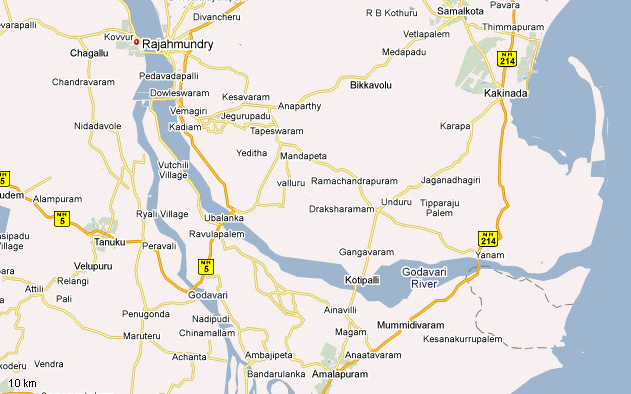
Rajahmundry and Kovvur on the Godavari River Just across the Godavari River from Rajahmundry is the place where the sage Gautama Rsi lived on the bank of the river. The place has long been known as Kovvur (Kovur or Kovvuru). There, Lord Caitanya bathed at the Gospada Ghat, a holy theertham still very popular today. Directly across from Kovvur, on the Rajahmundry side of the Godavari are the temples of Sri Kotilingeswar, Markandeya, Ayappa, and Maha Lingam. There is also a large ISKCON temple, known as Sri Sri Radha Gopinath Dashavatar Temple.
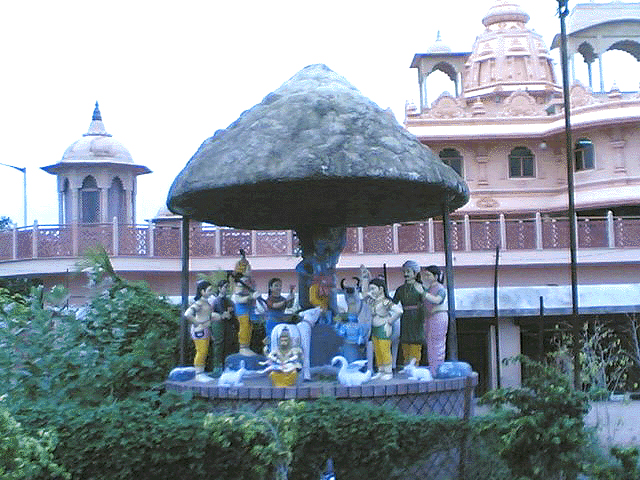
ISKCON Rajahmundry On the Kovvur side of the river is the ancient Gospada Ghat where Mahaprabhu took His bath. Known today as the Vidya Gospada Kshetramu, Gostanadi Teeramu at Kovvuru, the ghat is one km from the center of modern Kovvuru. This is the place where the sage Gautama lived and performed austerities. Today, the Gospada Ghat is separated from the city of Kovvur by a bridge. On the water side of the highway is a stretch of ghats along the river's edge. The bridge and highway which separate the ghats from the city are very much like the proposed Keshi Ghat, which would separate the Keshi from Vrindavan, if developers have their way. In fact, there are now three bridges across the Godavari River, linking Kovvuru with Rajahmundry.
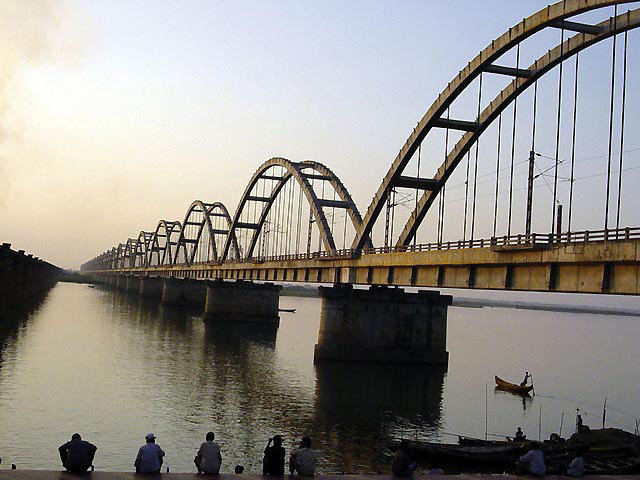
Bridge over the Godavari Ghats at Kovvur On the Gospada Ghat side there are various mandirs and facilities, including an Ayyapa Swami Temple, the Kovvur Sundareswara Swami Temple, and the Srimad Bhagavata Geetha Mandiram. While the cows once came here to drink (gospada means 'cows hoof'), once again the sacred cows have given way to a river of cars. Regardless, devotees still come in numbers to bath at Gospada Ghat, as can be seen in this recent YouTube video. Kovvuru and Rajahmundry Kovvuru, in the West Godavari district, hosts a mela every 12 years known as the Godavari Pushkaralu. Devotees come from the many small villages surrounding Kovvuru, including Vadapalli, Thougummi, Pasivedala, and Dommeru. Other temples in Kovvuru include the Sarswathi Mandiramu, the Sivalayam temple, Gayatridevi temple, Ramalayam temple, and Krishna temple. For all the bridges and cars, Rajahmundry remains the focus of development and commerce. There are various ghats along the Godavari on the Rajahmundry side, as well. One of the most visited temples there is the Kotilingalu, which is home to a reported 10 million Sivalingas. The ISKCON temple is also a large and much visited site.
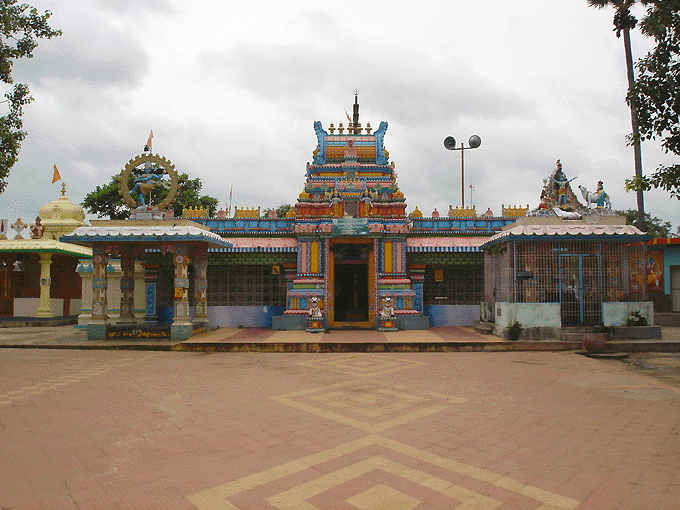
Gopadala Revu Sivalayam at Kovvur Lord Caitanya's Pastimes at Gautami-ganga In previous segments on Vidyanagara (part one and part two), we described Lord Caitanya's travels to Vidyanagara and His meetings with Sri Ramananada Raya along the Godavari River. We now find a nice connection between the Vidyanagara pastimes and Gautami-ganga, through the person of King Prataparudra. Even before his personal meeting with Lord Caitanya at Gautami-ganga, Maharaja Prataparudra had taken instruction in Srimad-Bhagavatam and the glories of Sri Krsna from Ramananda Raya, who served under the king of Rajamahendri. In his devotional work, Jagannatha-Vallabha-Natakam, Ramananda Raya offers dedications before each song to King Prataparudra, honoring his taste for hearing about the transcendental pastimes of Sri Sri Radha-Krsna. In his transcendental tome entitled Sri Rai Ramananda, HDG Srila Bhaktisiddhanta Saraswati Thakura provides a very wonderful description of Lord Caitanya's pastimes with King Prataparudra here at Gautami-ganga, on the banks of the sacred Godavari at Kovvur. by Srila Bhaktisiddhanta Saraswati Thakura CHAPTER I "Four centuries ago, about the year 1512 A.D., the western bank of the Godavari at Kovvur, on the most memorable day in the History of the world, witnessed a remarkable march of a band of Vedic Brahmanas chanting mantrams, attended with a performing concert of numerous Indian musical instruments playing before the procession in State of the Governor of Godavari Province of the Empire of the Ganga dynasty of Utkal. This pompous procession was meant as the accompaniment for a ceremonial bath in the sacred Godavari whose sanctity is well established from time immemorial. The bather was a no less conspicuous entity than the Governor of the mighty Emperor of Orissa, Sri Prataparudra Deva the greatest Ruler of the famous Ganga Dynasty whose members bore the proud designation of the Gajapatis or Lords of Elephants. The spectacle visualized the fact that the occasion was intended for seeking an accession of Virtue and piety by a great Luminary of the Imperial Firmament who evidently wanted to popularize himself to be a religious personage guiding the reins of the administration of a great King. Just before the party was approaching the holy bathing ghat of Gospada opposite to Kotilingam at Rajmundry, an Ascetic was observed to cross the river from the opposite bank to Pushkaram or Gospada. The very desire of having an ablution in the sacred stream fortunately brought One Who is the object of the eternal service of all unalloyed souls. The unbounded mercy that was hidden under the garb of the ascetic was showing unusual aptitude to meet a man of an apparently different caliber possessed of all royal grandeur quite in contravention to conditions of life invited by a sannyasin who deserted all earthly hopes of having any aid from busy sections of mundane meddlers. This unusual meeting of those two extremes, as would seemingly appear before the public eye, will not reconcile the conflicting thoughts of an ordinary observer. This spot with its most precious transcendental association has at last been recovered from the dungeon of forgetfulness or oblivion by one of their humble servants after the lapse of forty decades. Naturally the present day observers will look forward to ascertain the details regarding what led the public to the preservation of the memory of the said incident. Why was the mendicant busy to meet a man of ruling position and what led the ablest head of the administration to come in close touch with an unknown figure void of all worldly ambition? The Governor had everything to do with the ascetic who also in his turn was travelling throughout the length and breadth of India in search of the Master and His comrades. Both of them found each other in the state which recalls the shrutimantram of the Mundaka as if dva sapurna sayuja, etc. Gentle readers! Perchance you may not be able to resist the natural impulse to inquire about the couple. To respond to the call of enquiry, we are furnishing the account which has a historical bearing. This ascetic was no other than Sri Krishna-Chaitanya, identical with Sri Krishna with His Consort Barshabanavi. The principal object, the observed of all observers, was no other than Rai Ramananda, identical with the serving maid known as Sakhi Vishakha of Braja-Leela. The damsel of Braja came to serve her Lord and Consort under the garb of exhibiting an easy lucid exposition of the transcendental manifestive phase to the reach of fortunate souls. The Supreme Lord--the Fountainhead of the Predominating Aspect of the Transcendental Region--assumed the phase of a servitor, seeking as if his Lord with all ardor, as well as ready to pick up His old friend, to facilitate an easy access to the solving of an intricate problem of eternal life of felicitous knowledge of the transcendence in phenomena. The immanence of both made the devotees alone to conceive them by their seeming features of transcendence. Their meeting disclosed facts which were a sealed book to the frailties of human mentality. So the memory of this place would be adequately immortalized by recollecting the greatest boon offered to the search of eternity. The nativity of our hero is alleged to be Bentpur in the District of Puri where his kinsmen are still traced as Choudhury Pattanayakas. He was descended in the Karan caste, which is a mixed caste of vaishya and sudra as Manava Dharma Shastra would tell us in describing the mixed apashadas. His father's name was Bhavananda Rai, who had four other sons. One of the sons, Gopinath, was employed in the service of the king, but was found guilty of embezzling some amount of the royal treasury which penalized his life by the decision of the prince. King Prataparudra, considering the defaulter a brother of Ramananda, granted mercy in sparing his life; whereas, the Supreme Lord exhibited His diffidence to grant him mercy by His devotee, the King. Another brother of his named Vaninath, used to serve faithfully the Supreme Lord in various ways, such as in conveying mahaprasadam, etc. Rai Ramananda was in the cadre of the highest service of the realm and he had to act as the Governor of East and West Godavari, being a faithful and trustworthy service-holder of the Emperor of Orissa who had extended his province to the north bank of the river Krishna. Highest reference was given of Sri Ramananda by Vasudeva Sarbabhauma Bhattacharyya, the then erudite professor of monistic Vedanta or Chinmatravada. His devotional activities together with his writings earned for him the fame of the greatest poet of the time. This trait of character was unequalled as well as his maintenance of ethical views was no less. The Supreme Lord was hurrying up to meet him in His journey to the South and was very eager to have his unique company of pure highest devotion. Rai Ramananda at the same time also cherished an unknown hope of coming in touch with the all-loving transcendental entity Sri Krishna. So They were united in the tie of love which has a serving aptitude for the one goal--the akhila-rasamrita-murty. Rai's excellent work, Sri Jagannath-ballava-natakam, was being written with the skill of a reputed rhetorician, and later on this drama attracted the attention of the Supreme Lord in His manifesting devotional rituals. The style is so very simple that a little knowledge of grammar can help the readers of any other languages originated from Sanskrit in following the same. Since his meeting with the Supreme Lord at Kovvur, Rai Ramananda strictly followed the counsel of his Master. He parted with his exalted position and returning to Puri awaited for the Supreme Lord in order to serve Him as a companion. During his period of retirement from the service of the emperor Rai Ramananda lived at the Jagannath Ballava Garden in the town of Puri where he was busily engaged in the practices of the transcendental services of all those girls whom he considered to be identical with the damsels of Braja."

The Godavari at Sri Gautami-ganga
| |